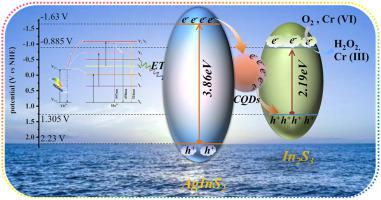Journal of Hazardous Materials ( IF 12.2 ) Pub Date : 2021-09-13 , DOI: 10.1016/j.jhazmat.2021.127172 Kailian Zhang 1 , Man Zhou 2 , Kai Yang 3 , Changlin Yu 4 , Ping Mu 1 , Zhenzhen Yu 1 , Kangqiang Lu 1 , Weiya Huang 1 , Wenxin Dai 5

|
The low-usage of solar energy and the sluggish separation efficiency of the photogenerated electrons/holes pairs are the obstacles in the practical application of photocatalysts. The integration of upconversion and Z-scheme heterojunction is expected to break the barriers to achieve the efficient charge separation and broaden near-infrared light absorption. Herein, an effective indirect Z scheme AgInS2/In2S3 heterostructure with carbon quantum dots (CQDs, as the electron conduction medium) and Lu3NbO7:Yb, Ho (as upconversion function) has been successfully synthesized. Consequently, the Lu3NbO7: Yb, Ho/CQDs/AgInS2/In2S3 heterostructure exhibited superior photocatalytic activities for Cr(VI) reduction and H2O2 production, reducing 99.9% of Cr(VI)(20 ppm, 15 min) and 78.5% of Cr(VI) (40 ppm, 30 min) with visible light irradiation as well as 94.0% of Cr(VI) (20 ppm, 39 min) under NIR light irradiation. Simultaneously, the heterostructure could generate 902.9 μM H2O2 for 5 h under visible light irradiation. The intensive photocatalytic properties could primarily be attributed to the boosted light absorption capacity, the improved solar-to-energy conversion by the remarkable upconversion capacity of Lu3NbO7: Yb, Ho/CQDs and the faster charge transfer through a Z-schematic pathway. This work is anticipated to open a novel “window” for designing the efficient photocatalysts by coupling of Lu3NbO7: Yb, Ho and CQDs.
中文翻译:

通过具有宽光谱响应的新型 Lu3NbO7:Yb、Ho/CQDs/AgInS2/In2S3 异质结构光催化 H2O2 生产和去除 Cr (VI)
太阳能利用率低和光生电子/空穴对分离效率低是光催化剂实际应用的障碍。上转换和Z型异质结的集成有望打破障碍,实现有效的电荷分离并拓宽近红外光吸收。在此,成功地合成了具有碳量子点(CQDs,作为电子传导介质)和Lu 3 NbO 7 :Yb,Ho(作为上转换函数)的有效间接Z方案AgInS 2 /In 2 S 3异质结构。因此,Lu 3 NbO 7 : Yb, Ho/CQDs/AgInS 2 /In 2S 3异质结构对 Cr(VI) 还原和 H 2 O 2生成表现出优异的光催化活性,可减少 99.9% 的 Cr(VI)(20 ppm,15 分钟)和 78.5% 的 Cr(VI)(40 ppm,30 分钟)可见光照射以及近红外光照射下 94.0% 的 Cr(VI) (20 ppm, 39 min)。同时,该异质结构在可见光照射下5小时可产生902.9 μM H 2 O 2 。Lu 3 NbO 7显着的上转换能力提高了光的吸收能力,提高了太阳能到能量的转换能力。:Yb、Ho/CQD 和通过 Z 示意图路径的更快电荷转移。这项工作有望为通过 Lu 3 NbO 7 : Yb、Ho 和 CQD的耦合设计高效光催化剂打开一个新的“窗口” 。











































 京公网安备 11010802027423号
京公网安备 11010802027423号